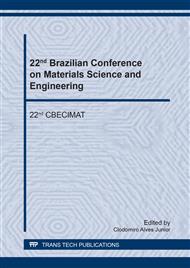p.90
p.95
p.101
p.107
p.115
p.120
p.125
p.131
p.137
Brick Drying Simulations by Finite Volume Method
Abstract:
There are numerous studies on the application of ceramic materials, such as bricks, in the various engineering and manufacturing fields. Ceramic bricks are manufactured from humidified clay and are classified as structural ceramics. When exposed to drying the process is not precisely controlled, defects such as cracks, deformations and warping can arise, which compromise the final physical and structural properties of the product. Seeking to solve the procedure through simulations, this work presents a numerical study on a brick drying. A three-dimensional transient model is presented to predict the temperature of the holed ceramic brick and the distribution of the humidity content in a drying situation inside a temperature controlled oven, the heat transfer and mass phenomena are present. As simulations were done in the ANSYS CFX® program, which uses the Finite Volumes Method and presented satisfactory results when compared with the experimental works.
Info:
Periodical:
Pages:
115-119
Citation:
Online since:
September 2018
Authors:
Keywords:
Price:
Сopyright:
© 2018 Trans Tech Publications Ltd. All Rights Reserved
Share:
Citation:


